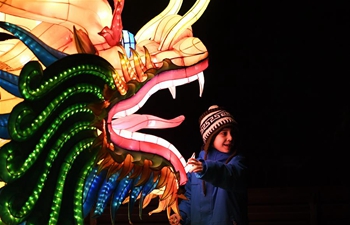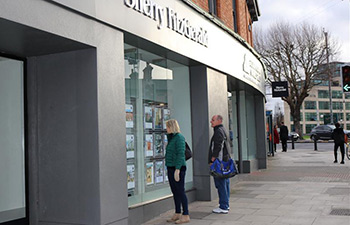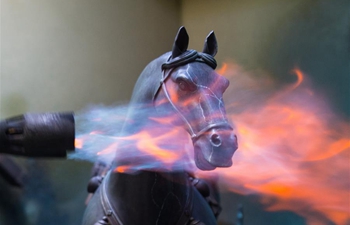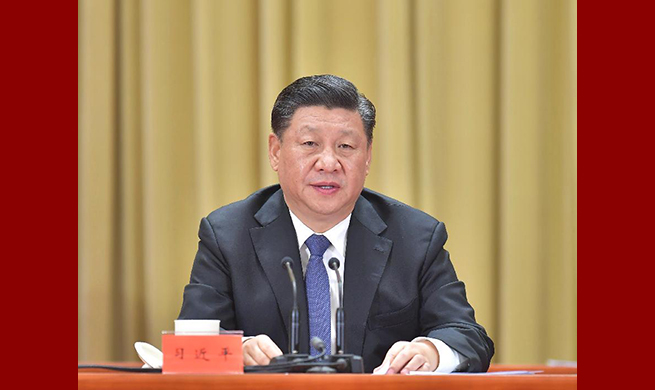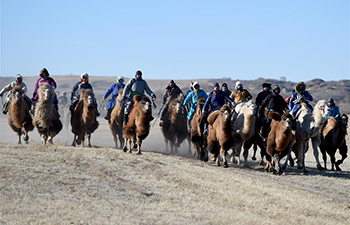NEW YORK, Jan. 3 (Xinhua) -- For another year, heart-wrenching scenes in the aftermath of mass shootings in the United States repeatedly made headlines in 2018 as gun violence was still rampant across the country despite a huge public outcry.
Panicked people were seen fleeing in all directions from deadly bullets; heavily-armed police stood by in maximum vigilance; tears were glistening amid candlelight in vigils; politicians expressed condolences but were shy of taking action.
According to Gun Violence Archive, a non-profit organization that tracks gun-related violence in the United States, more than 56,800 shootings took place in 2018, killing over 14,600 people and injuring some 28,000 -- a slight decline from 2017 but still staggeringly high.
On average, some 40 lives were taken by guns every day across the country as a result of personal conflicts, gangster wars, terror attacks, or public place shooting rampages, among others. Nearly 3,500 of the victims were under 18 years old.
DEADLIEST ATTACKS
In terms of mass shooting, which generally means a shooting incident with four or more victims, several attacks recorded in 2018 turned out to be among the bloodiest in modern American history.
On Valentine's Day, 19-year-old Nikolas Cruz, a former student at Marjory Stoneman Douglas High School in Parkland, the U.S. state of Florida, opened fire on campus with an assault-style rifle, killing 17 students and educators within 6 minutes and 20 seconds.
Three months later in Santa Fe, Texas, a 17-year-old shooter killed 10 and wounded an equal number of others with a shotgun and a .38 revolver in Sante Fe High School, about 54 km southeast of downtown Houston. Many of the victims had attended the same classes with the shooter.
In October, a synagogue in Pittsburgh, Pennsylvania, was left in a bloodbath after 46-year-old Robert Bowers killed 11 and injured six others during a baby naming ceremony on a quiet Saturday morning. He was using an AR-15 assault rifle and three Glock .357 handguns in what was believed to be among the deadliest attacks against the Jewish community in the United States.
In November, 28-year-old Ian David Long, a former U.S. Marine, opened fire at the Borderline Bar and Grill in Thousand Oaks, a suburb about 64 km northwest of Los Angeles, using a Glock .45 handgun with an extra-capacity magazine. Thirteen people were killed and 11 others injured, many of them college students.
Regardless of the motivations or mental status of the attackers, they seemed to have chosen guns as their weapons so as to maximize the harm, and they especially preferred semi-automatic guns that could be legally acquired in many U.S. states.
FRUITLESS DEBATES
Guns have become a coherent part of American culture ever since the founding of the country. According to a decade-long survey released by the Graduate Institute of International and Development Studies in Geneva in June 2018, U.S. citizens, who make up only 4 percent of the world population, own some 40 percent of all guns in the world.
Despite widespread gun-related violence and tragedies, gun control has remained one of the most divisive issues among Americans, with a distinct partisan feature. Polls have shown that Democrats generally support gun control while a vast majority of Republicans are gun-rights hardliners, citing the Second Amendment of the U.S. Constitution as proof of their undeniable rights.
In recent years, debates over gun laws were revived several times in the wake of major shooting massacres, especially after the Sandy Hook Elementary School shooting that claimed the lives of 20 children, and the 2017 Las Vegas carnage that left 59 dead and over 400 wounded.
However, little progress was made by the administrations under President Barack Obama or President Donald Trump in this aspect, either failing to gain congressional support or lacking the political will.
"To be honest, politically they (the guns) are not going away. We will never see strict gun control in the United States," Jon R. Taylor, a professor of political science at the University of St. Thomas in Houston, Texas, has told Xinhua.
"Part of it is the Second Amendment because U.S. Supreme Court has ruled consistently over roughly about 130 years or so that state has not the right to strictly restrain the gun ownership and usage," Taylor said.
"What happened politically is that we get the same mindset of that yes this is terrible, yes this is tragic, yes something should be done, and then a week or two later something else gets our attention. And the gun issue declines. It's never an issue in presidential campaigns. It's brought up but nobody would really talk it that much other than the occasional mass casualty incident," he added.
The problem is also rooted in the obstruction from gun lobbying groups that have been "very vocal in preventing meaningful legislation that can prevent gun violence from passing Congress," said Kyleanne Hunter, vice president for programs at the Brady Campaign and Center to Prevent Gun Violence, a not-for-profit organization dedicated to the fight against gun violence.
"The gun lobby has been hijacked by corporate interests that profit from increased gun sales. They have put quite a bit of money into blocking meaningful legislation," Hunter said in a written interview with Xinhua.
ACTIONS AND HOPE
Still, the year 2018 saw many gun control activists, especially the younger generations, alarmed by the tragic school shootings, stand up against the long-time inaction of politicians and push for some real changes.
Led by survivors of the Parkland, Florida shooting, hundreds of thousands of Americans, mostly teenagers, gathered in Washington, D.C. for March for Our Lives event on March 24.
Holding signs that read "Never Again" and "Am I Next?", crowds of angry protesters flocked to the Pennsylvania Avenue, which connects the White House to the U.S. Capitol, calling for stricter gun laws to ensure school security and protect the country's future.
"I have a dream that enough is enough," nine-year-old Yolanda Renee King, granddaughter of Martin Luther King, told the crowd. "And that this should be a gun-free world, period."
Meanwhile, some 800 marches happened in various U.S. cities from coast to coast. In New York, former Beatles member Paul McCartney joined the rally and made a stop at a Central Park memorial honoring his former band mate John Lennon, who was shot and killed in this area in 1980. "One of my best friends was killed in gun violence right around here, so it's important to me," McCartney told CNN, referring to Lennon.
A number of student activists for gun control emerged from the event, who were hailed by some U.S. pro-gun control media as representatives of the country's new generation that could make a difference. They were on TV interviews and magazines covers, taking a firm and unwavering stance on gun control and protecting young Americans.
Some positive progress has also been made on the level of state legislatures. According to a recent report published by Giffords Law Center, 67 new laws regarding gun control were enacted in 2018 in 26 states and Washington, D.C., tripling that in 2017.
The new regulations on gun use include raising the minimum age to buy guns, banning ghost guns and bump stocks, disarming domestic abusers, among others.
"One of the main takeaways from the 2018 (U.S. midterm) elections was that guns were no longer an off-limit issue. In fact, (some) newly-elected members of Congress ran specifically on the issue and won," said Hunter.
In the "Brady 2018: National Electoral Report" published by Hunter's organization, the 2018 midterm elections were labeled as "a major victory" for the future of gun violence prevention (GVP).
"In key races across the country, NRA (National Rifle Association)-backed lawmakers with a long history of blocking even basic progress towards passing sensible gun laws, were defeated by candidates who ran and won on a GVP platform," the report noted.
However, neither the March for Our Lives nor the progress in state gun laws has been able to prevent fresh shooting tragedies from happening, including those in Santa Fe, Pittsburgh and Thousand Oaks.
While there are good signs of hope, the road for effective gun control in the United States is almost certain to remain long and thorny.
